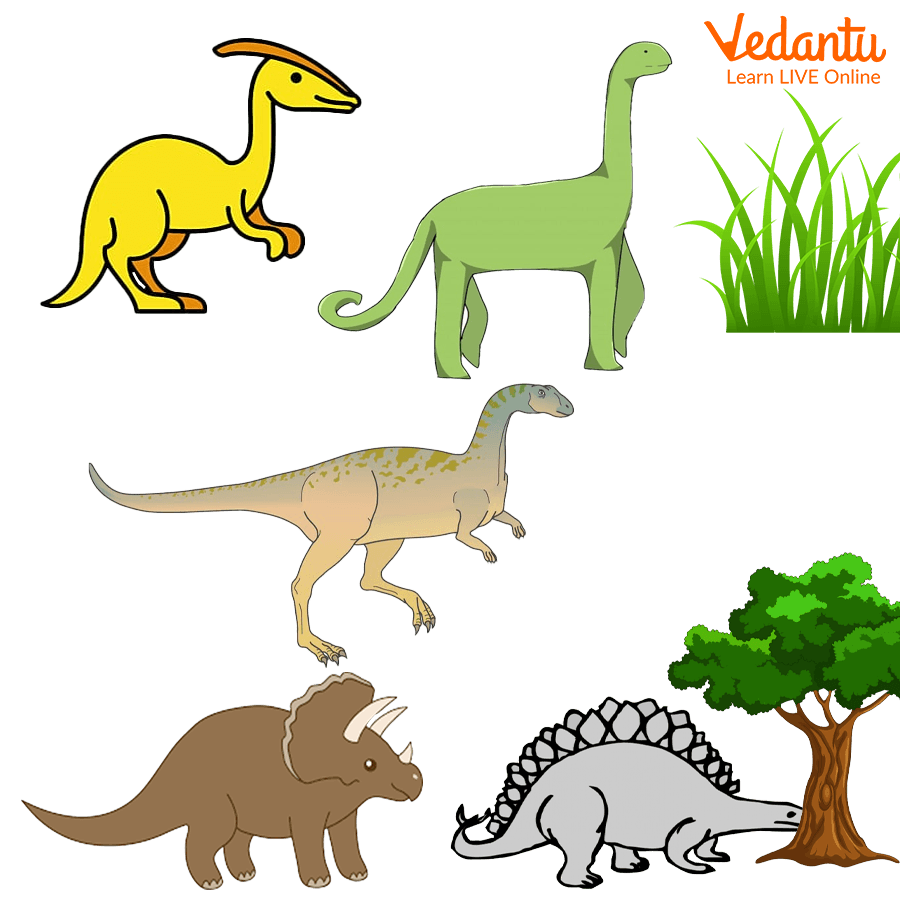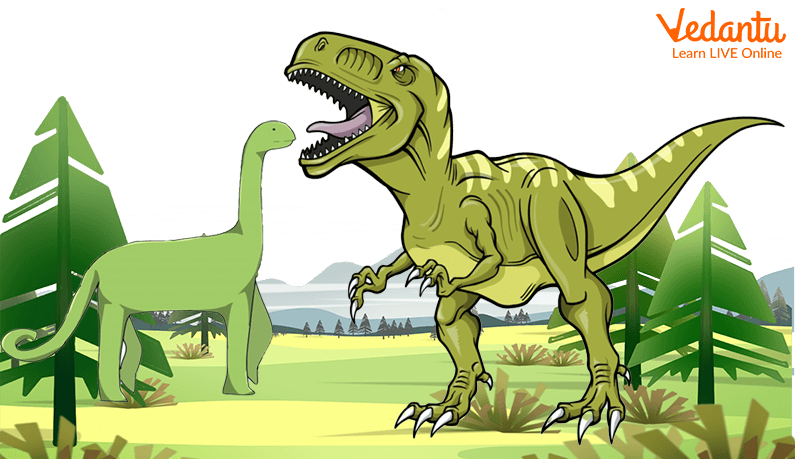




Types of Dinosaur Diets: Herbivores, Carnivores & Omnivores
Dinosaurs were large creatures that lived a long time ago. They inhabited the land, water and some also flew in the sky like birds. What exactly are they? Of course, we're talking about dinosaurs. Your small ones will learn about what dinosaurs ate while singing along and having fun with this song!
The common term dinosaur (clade Dinosauria) refers to a group of gigantic reptiles that first emerged around 245 million years ago (at the start of the Middle Triassic Epoch) and lasted nearly 180 million years. Most died out around 66 million years ago, at the end of the Cretaceous Period, but numerous lines of evidence now imply that one branch developed into birds around 155 million years ago.
Consider your teeth. Some are made to shred a burger, while others are shaped to pulverise a salad. We'll explore what dinosaur teeth reveal about what they ate a long time ago in this session.
As you can see, it all relied on what kind of dinosaur they were and what kind of teeth they possessed. Plant eaters would have eaten leaves, twigs, and seeds from conifers, geiko plants, redwoods, yews, pines, cypress, and cycads, among others. They may have consumed angiosperms and other blooming plants as well. Meat eaters, on the other hand, were likely to feed not just on the corpses of dinosaurs they hunted or scavenged but also on insects. Omnivores most likely ate whatever was available, whether it was an animal, a vegetable, or an insect.
Plant-eating Dinosaurs (Herbivores)
Plants were consumed by these animals. They fed on plants and ferns and typically lived in herds. Plant-eating dinosaurs were most likely the majority of the species that existed. These dinosaurs possessed flat teeth that were useful for removing leaves off trees as well as crushing down fibrous plant stuff. To augment their meals, these herbivores most likely ate twigs and seeds, among other things. Some experts believe that these plant-eating creatures also ate stones. Exactly like today's birds. These stones would aid in the further grinding down of the plant material in their stomachs so that the nutrients could be extracted.

Plant-eating Dinosaurs
Meat-eating Dinosaurs (Carnivores)
The meat-eating dinosaurs were carnivorous animals that scavenged or hunted prey. Some animals are classified as omnivores, meaning they ate both plants and smaller animals or insects. When we think about dinosaurs, we generally imagine a massive T. rex with sharp jaws devouring other dinosaurs. Carnivores are dinosaurs that ate solely meat, such as the T. rex. Meat-eating dinosaurs moved around on two muscular legs in order to capture their meal quickly. Dinosaurs, including other dinosaurs, ate lizards, eggs, and other creatures. The Spinosaurus, which lived around 97 million years ago in North Africa, is the biggest carnivorous dinosaur yet unearthed. This nearly 60-foot-long dinosaur could swim and ate fish flesh as a diet.

Meat-eating Dinosaurs
The Dinosaurs Song
While singing along to this nursery rhyme, your small ones will learn about what dinosaurs ate.
Have you ever seen a dinosaur,
a dinosaur, a dinosaur?
Have you ever seen a dinosaur
eat grasses and meat?
Eat meat and eat grasses?
Eat meat and eat grasses?
Have you ever seen a dinosaur
eat grasses and meat?
Have you ever seen a herbivore,
a herbivore, a herbivore?
Have you ever seen a herbivore
eat grasses and plants?
Eat plants and eat grasses?
Eat plants and eat grasses?
Have you ever seen a herbivore
eat grasses and plants?
Have you ever seen a carnivore,
a carnivore, a carnivore?
Have you ever seen a carnivore
eat insects and meat?
Eat meat and eat insects?
Eat meat and eat insects?
Have you ever seen a carnivore
eat insects and meat?
Have you ever seen an omnivore,
an omnivore, an omnivore?
Have you ever seen an omnivore
eat grasses and meat?
Eat meat and eat grasses?
Eat meat and eat grasses?
Have you ever seen an omnivore eat grasses and meat?
In this children's song, the young ones will travel back in time to discover more about dinosaurs. As watches numerous dinosaurs wandering freely on the land, it looks like they are having lunch. Not all dinosaurs eat the same things; some eat grasses, some meat, others insects, and still others consume a little bit of everything!
Conclusion
Herbivores are animals that feed mostly on plants and grasses. One of the most well-known herbivores, the Brachiosaurus, possessed long necks and ate foliage from the trees. Last but not least, what do you name dinosaurs that consume both grass and meat? Omnivores! These are the dinosaurs who consume everything, such as the Oviraptor, which was one of the tiniest but also one of the fastest and lightest.
Learning about the various eating habits of creatures such as dinosaurs may be beneficial for children, and it's a good idea to do so through children's songs because they tend to make learning entertaining and allow youngsters to comprehend the topic more naturally. It's also a fantastic introduction to science for children! Children can become better learners in general when learning about these amazing species since they must dig for knowledge in order to learn about their favourite creatures. Therefore, it will enable absorbing strategies on how to process information and investigate a new topic.
FAQs on What Do Dinosaurs Eat? Simple Guide for Curious Students
1. What were the main dietary groups for dinosaurs?
Dinosaurs are generally classified into three main dietary groups based on what they ate. The majority were herbivores (plant-eaters), others were carnivores (meat-eaters), and a smaller group were omnivores, who ate both plants and animals.
2. What kind of plants did the herbivorous dinosaurs eat?
Herbivorous dinosaurs ate a wide variety of plant life available during the Mesozoic Era. Their diet often included:
- Ferns
- Cycads (a type of seed plant)
- Conifers (like pine trees)
- Ginkgoes
- And later in the era, flowering plants.
They had to eat large quantities of this tough vegetation every day to get enough energy.
3. What did large carnivores like the T-Rex typically eat?
Large carnivorous dinosaurs, such as the Tyrannosaurus Rex, were apex predators at the top of the food chain. They primarily hunted other large dinosaurs, especially herbivores like the Triceratops and Edmontosaurus. They were also likely scavengers, meaning they would eat carcasses they found.
4. How do scientists know what dinosaurs ate millions of years ago?
Scientists discover dinosaur diets by studying several types of fossils. The most important clues come from:
- Fossilised teeth: Sharp, serrated teeth suggest a meat-eater, while flat, grinding teeth indicate a plant-eater.
- Stomach contents: Rarely, the fossilised remains of a dinosaur's last meal are found in its stomach area.
- Coprolites: This is the scientific name for fossilised dinosaur droppings, which can contain fragments of bone or plant matter.
5. Why did different dinosaurs have such different types of teeth?
A dinosaur's teeth were specialised tools perfectly adapted to its diet. Carnivores like Velociraptor had sharp, pointed teeth to tear flesh. In contrast, herbivores like the Triceratops had rows of flat teeth designed to shear and grind tough plant material. Some long-necked herbivores even had peg-like teeth just for stripping leaves off branches.
6. Is it true that dinosaurs ate humans?
No, dinosaurs and humans never lived at the same time. The last dinosaurs died out about 65 million years ago, whereas the earliest ancestors of humans appeared only a few million years ago. Therefore, it was impossible for a dinosaur to have ever met, let alone eaten, a human.
7. Were there any dinosaurs that ate both plants and meat?
Yes, these dinosaurs are called omnivores. While they were less common than pure herbivores or carnivores, they had a mixed diet. A good example is the Oviraptor, which is believed to have eaten a variety of foods including eggs, small reptiles, insects, and plants. Their beaks were versatile for crushing different kinds of food.
8. Can you give some examples of famous herbivore and carnivore dinosaurs?
Certainly! Here are some of the most well-known dinosaurs from each group:
- Famous Herbivores (Plant-Eaters): Triceratops, Stegosaurus, Brachiosaurus, and Ankylosaurus.
- Famous Carnivores (Meat-Eaters): Tyrannosaurus Rex, Velociraptor, and Spinosaurus.





















